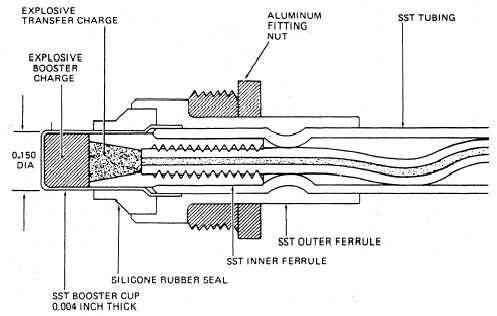support is cut by a second shaped charge attached
at the bottom.
Fillet Support Severance Explosive Shaped
Charge.— A shaped charge is attached at the
bottom of the internal fillet support to cut the
support to allow the-fillet to separate from the
aircraft during the emergency egress system
operation (fig. 6-11).
Shielded Mild Detonating Cord (SMDC).—
The 31 SMDC segments (fig. 6-12) act as
the plumbing for the emergency egress system.
The SMDC connects all external and internal
jettison handle/initiators; all connectors, tees,
and manifolds or one-way transfers; all
explosive charges; and all explosive shaped
charges. Each SMDC segment is loaded with
1 to 2 grains per foot of hexanitrostilben
I (HNS I). When initiated, the extremely
high velocity and pressure of the cord is
focused onto the end of the next adjacent
SMDC segment, which acts as an acceptor
charge.
Shielded Mild Detonating Cord (SMDC)
Manifold.— Two SMDC manifolds are located
on the pilot’s and copilot’s bulkhead. The
SMDC manifold acts as a check tee or
one-way detonating transfer device. The SMDC
manifold is a self-contained unit housing a
sealed receptacle for dual-shaped charges. Any
detonation entering the side ports from either
direction will transfer to the aft port. Any
detonation originating from the aft port
(TACCO or SENSO) segment of the SMDC
manifold will not transfer back into the
side portions. This would occur when either the
TACCO or SENSO elects to cut the respective
hatch; the remaining two windows and the
opposite hatch would not be affected.
MAINTENANCE REQUIREMENTS
Maintenance on ejection seats is primarily
performed during aircraft inspections. The
ejection system could be called a dormant system,
as it is only operated in an emergency situation.
A true functional test of the complete system can-
not be performed because of the destructive
functions of some of the components. For this
reason it is of the utmost importance that you
thoroughly know all aspects of the ejection system
that you perform maintenance on and follow all
the steps for testing components as outlined in the
maintenance instructions manual (MIM).
Figure 6-12.—Shielded mild detonating cord tip (typical).
6-16



